3:計画はどんな内容か 3-2-3
3-2-3.水循環を保全するための具体的な手だて。
(1)水源地がある流域の森林を保全し、里山の利活用を推進する
1) 【森を守る】天然林の不伐地域を明確にし、効果的に保全する
天然林は、地表及び地中の生物の多様な生息環境として優れていることから、降水の地下保水能力や浄化能力も高いと言われています。ニセコ町は水源地の多くを湧水に頼っていますので、水源地周辺の天然林が保全されるかどうかは、とても大事なことです。
ニセコ町の天然林は減少傾向にあります。豊かな水源を守るためには、大規模な皆伐を避け、小さな規模の択伐式伐採を行うなどの方法で、天然林を保全する必要があります。
ニセコ町の天然林は減少傾向にあります。豊かな水源を守るためには、大規模な皆伐を避け、小さな規模の択伐式伐採を行うなどの方法で、天然林を保全する必要があります。
- 目標達成の手だてと重点的な手だて
- 天然林の実態を把握します。
- 所有者との間で、天然林の保全協定を結びます。→【重点的な手だて】
- 水源地周辺不伐の森林保全条例を制定します。
- 大規模皆伐を避けます。
- 目標値:天然林の保全面積=(2004年度に策定)
- 目目目標達成に向けた手だてと主体別の行動項目
| 目標達成の手だて | わたしたち町民の行動項目 | コミュニティの行動項目 | 事業者の行動項目 | 行政(役場)の行動項目 |
| 1.天然林の実態を把握する | ・天然林など森林の実態調査への参加 ・名木、巨木など保全の象徴となる木の調査への参加 | ・天然林など森林の実態調査への参加 ・名木、巨木など保全の象徴となる木の調査への参加 | ・所有天然林など森林の実態調査に向けた条件整備 | ・天然林など森林の実態把握調査の実施。特に、水源地周辺の林相調査 ・「森林整備計画」に基づく水源保全機能重視地域の保全策検討 |
| 2.所有者との間で、天然林の保全協定を結ぶ【重点的な手だて】 | ・保全協定の締結協力 ・「環境マスター」によるチェック活動 ・高山植物を採取したり買ったりしない | ・所有者を含む地域コミュニティによる保全協定の締結支援 | ・保全協定の締結に協力する ・所有天然林の伐採はなるべく避け、代替手段を検討する ・高山植物を採取したり売ったりしない | ・水源地周辺を中心に不伐を原則とする対象地域を明確にし、所有者との間で可能な範囲で保全協定を締結する ・所有者に関する情報の集約 ・「環境マスター」によるチェックシステムの構築 ・水源地周辺については用地の借り上げあるいは購入、トラストなども検討する |
| 3.水源地周辺不伐の森林保全条例を制定する | ・条例制定への町民参加 | ・水源地周辺地域コミュニティにおける条例制定に向けたワークショップ | ・条例制定への事業者参加 | ・水源地周辺不伐の森林保全条例の制定を検討する ・水源地への植林 ・現行条例に基づくニセコ町環境保全林との整合性検討 |
| 4.大規模皆伐を避ける | ・大規模皆伐の実態把握への参加 ・「環境マスター」による皆伐の是非の検討 | ・実態把握への協力 | ・所有者は大規模皆伐を避け、群状又は帯状皆伐、あるいは傘伐や択抜などを採用し落枝 ・落葉の流出や表土の流出を防ぐ | ・町有林の大規模皆伐を避け、群状または帯状皆伐、あるいは傘伐や択抜などを採用し、落枝・落葉の流出や表土の流出を防ぐ |
- 注4:「環境マスター」=ニセコ町民の中から、環境の様々な問題に詳しい人や関心を持って活動している人を任命し、ニセコの様々な環境問題に適切なアドバイスや環境行動へのサポートをしてもらおう、という仕組みのアイディアです
- 目標値の背景となる指標A=天然林と人工林の面積の推移(グラフ)
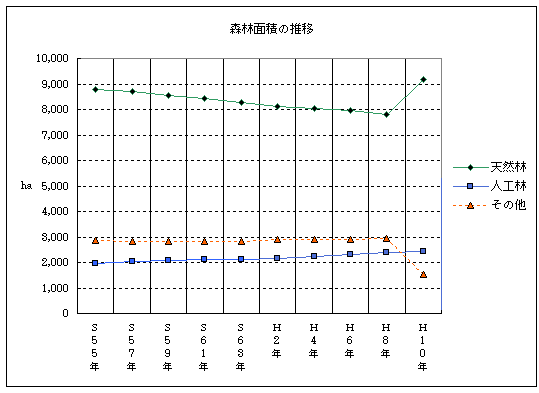
- 天然林は年々減少し続け、反対に人工林は増えています。合わせた森林総面積は、減少の一途をたどっています。
2) 【森を育てる】森林の管理、育成を進める
森林に生息する土壌生物は、落葉・落枝を腐らせ分解することによって自らの栄養分を得ています。土壌生物のこのような活動によって、土壌の細かい粒子が結合して大きな粒子ができ、間に隙間が生じてスポンジのような団粒が形成されます。この隙間が雨水を吸収し、河川等への流出量を平準化して洪水を防止したり渇水の緩和に役立つ "緑のダム"機能を有するのです。また、緑のダムは、表土や養分の流出を抑制し、流域の水質を保全する役割も果たしています。これらの機能を維持するためには、森そのものを育てていかなければなりません。
目標達成に向けた手だてと主体別の行動項目
- 目標達成の手だてと重点的な手だて
- 複層林の植林を促進します。
- 育林産業を振興します。
- 間伐材や林産物のリサイクルを進めます。→【重点的な手だて】
- 目標値:植林面積=民有林3,879ha、道有林241ha(目標年次:平成44年)
目標達成に向けた手だてと主体別の行動項目
| 目標達成の手だて | わたしたち町民の行動項目 | コミュニティの行動項目 | 事業者の行動項目 | 行政(役場)の行動項目 |
| 1.複相林の植林を促進する | ・小規模伐採の跡地への複層林の植林を進める | ・植林活動への協力 | ・小規模伐採の跡地への複層林の植林を進める | ・小規模伐採の跡地への複層林の植林を進める ・「森林整備計画」に基づく育林 |
| 2.育林産業を振興する | ・育林ボランティアあるいはNPOの活動を町内外に展開する | ・ボランティア受け入れの仕組みづくり・ボランティア活動の団体づくり | ・新規就業者の発掘 | ・新規就業促進の仕組みづくり |
| 3.間伐材や林産物のリサイクルを進める【重点的な手だて】 | ・消費者からの商品ニーズの発信 | ・間伐材を活用したリサイクル製品の開発(木炭製造など)と市場開拓 | ・間伐材利用方法の検討 ・新規事業化の支援 | |
| ・間伐材やおが屑、樹皮などの林産物は堆肥センターなどで堆肥化する | ・堆肥センターの早期の効率的稼働 |
- 目標値:植林及び林相改良の面積
(「ニセコ町森林整備計画より」目標年次:2032年)
- 目標の背景となる指標B=林業従業者の推移〔グラフ)
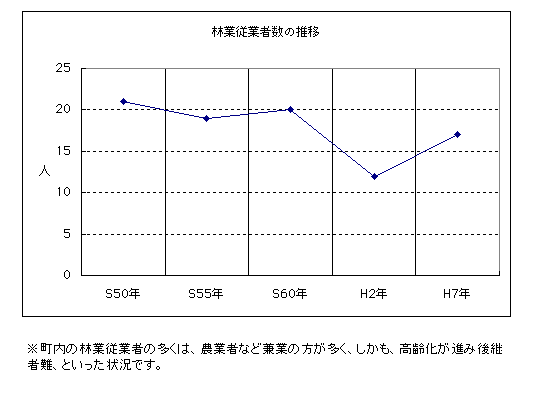
3)【身の回りの緑を大切にする】里山の育成と管理を進める
ニセコ町の里山でも、近年は全国各地の場合と同様、手入れ不足に伴う問題が様々な形で表面化しています。今後は、二次林だけでなく周辺の農地やため池、特に里山を流れる河川の流域河畔林などを含めた地域全体の生活文化を視野に入れた取り組みと、里山管理の担い手不足を解消する社会活動的なアプローチなど、総合的な対策が必要です。
また、里山は人間社会による様々な関与によって維持されるため、そこには自然と人間の関係が作り出す多様な生物の生息環境が創出され、持続します。この多様な野生生物の生息状況を、自然観察によってデータベース化し、それらの保全につとめることも里山の重要な機能維持のひとつです。
- 里山人間の手が入った身近な雑木林などを「里山」と言いますが、国土のかなりの部分を占めており、自然との触れあいの場所としてだけでなく、山菜など地域に住む私たちの資源採取の場にもなっています。地域によって、里山の植生のタイプや生活・生産活動、文化的背景などが異なっていますが、その多くは自然度7(注:図表参照)の二次林を指しており、北海道の場合はシラカンバ林が主体になるところが多く見られます。ニセコ町では、いこいの村や弥照神社、忠魂碑の周辺、羊蹄山周辺、農家の裏山などに里山が存在しています。
また、里山は人間社会による様々な関与によって維持されるため、そこには自然と人間の関係が作り出す多様な生物の生息環境が創出され、持続します。この多様な野生生物の生息状況を、自然観察によってデータベース化し、それらの保全につとめることも里山の重要な機能維持のひとつです。
- 目標達成の手だてと重点的な手だて
- 里山の実態を把握し、その役割について認識を深めます。
- 百年の森構想によって、里山の造林事業などを推進します。
- 里山復元のモデル事業を町民参加で推進します。
- 里山の河畔林を、地形や生態系ぐるみで保全します。
- 里山の利活用や適正な管理運営の仕組みをつくります。 →【重点的な手だて】
- 里山と親しむライフスタイルを創造します。
- 目標値:里山認定箇所数=10箇所以上
- 目標達成に向けた手だてと主体別の行動項目
| 目標達成の手だて | わたしたち町民の行動項目 | コミュニティの行動項目 | 事業者の行動項目 | 行政(役場)の行動項目 |
| 1.里山の実態を把握し、その役割について認識を深める | ・近くの里山の観察体験を行う ・「里山さがし」をする ・過去にどのような里山活用を行っていたか聞き取り調査を行う ・里山と親しむことによって、森についての理解を深める・里山に生息する多様な野生生物の観察を続け、記録を作成する。 | ・地域コミュニティごとに、里山の実態を見直すウオッチングを実施・個人所有の里山については共同利用のルールづくりを進める・地域に眠る里山歴史の掘り起こし運動を推進 | ・観察体験の受け入れ環境やルールを整える | ・里山の場所の特定に関連する認定制度づくり・観察会の仕組みづくりの支援・共同利用のルールづくりへの支援(不在も含めた地主との調整など)・町民主体で調べた里山の野生生物の生息記録をデータベースに整備し、保全策を検討する。 |
| 2.「百年の森構想」によって、里山の造林事業などを推進する | ・「百年の森」づくりに積極的に参加する | ・地域コミュニティごとに、造林・育林支援活動を行う・学校林の維持管理育林活動の推進 | ・「百年の森」植林事業の準備など、町民参加の森づくりの支援 ・「森と緑の会」などの住民組織やNPO、地域コミュニティによる植樹、育林活動への支援 | |
| 3.里山復元のモデル事業を町民参加で推進する | ・モデル地区における里山復元の事業に参加する(調査、計画、実施) | ・モデル地区における里山復元の事業に参加する(調査、計画、実施) | ・モデル地区における里山復元の事業に参加する(調査、計画、実施) | ・モデル地区における里山復元事業の実施(里山公園) |
| 4.里山の河畔林を地形や生態系ぐるみで保全する | ・保全したい河畔林の候補地を選出する | ・地域コミュニティごとに、保全対象となる河畔林や自生植物群落を選定する | ・保全すべき河畔林を選出し、保全手法を検討する・保全すべき自生植物群落(カタクリ、ヤチブキなど)の保全策の検討 | |
| 5.里山の利活用や適正な管理運営の仕組みをつくる【重点的な手だて】 | ・「環境マスター制度」など仕組みづくりへの参加・野鳥を呼び寄せる多様な植生の保全・在来種を学ぶ各種事業の創出と参加 | ・個人所有の里山については共同利用のルールづくりを進める・里山の地域単位で、管理組合の可能性を検討する・神社周辺の森の維持管理育林の仕組みづくり・資源の持続的利用に向けたマナーとルールの検討 | ・里山所有者は、利用に向けた管理運営体制を再整備する | ・町有林の利用に向けた管理運営体制を再整備する・「環境マスター制度」など町民参加の仕組みづくり・在来種を学ぶシステム作り |
| ・手入れができない里山のボランティアあるいはNPOの仕組みを町内外につくる | ・ボランティア受け入れの仕組みづくり | |||
| 6.里山と親しむライフスタイルを創造する | ・余暇活動に森林散策を楽しむなどのライフスタイルの創造 | ・地域ごとに説明指導員を育成・ふるさと教室の活性化とリーダーバンクの充実・高齢者の知恵と経験を子どもたちに伝える地域活動 | ・利用可能な里山のPRを図る |
(2)河川流域の農業用水の循環利用を高め、河川や地下水への汚染負荷を低減する
1) 【クリーン農業を進める】大量の農薬や窒素肥料に依存する農業から、クリーン農業への転換を進め、水系への環境負荷を軽減する
水田には、下流の地下水を涵養する機能の他、水に溶けているアンモニアや硝酸などの窒素分を土壌中の微生物が窒素ガスに変化させるはたらきがあります。この点で、水稲を作付けしている水田や水を張った休耕田は、水循環に良い影響を与えています。しかし、ニセコ町では水田の経営耕地面積が減少傾向にり、地下水の涵養機能が低下していると思われます。
土壌診断によると、ニセコの畑土壌は、低いpH、カリ成分過多、そして石灰分不足が特徴となっています。土づくりに欠かせない肥料の国内需要を成分別に見ると、リン、窒素、カリとも、増減を繰り返しながらも全体としては減少傾向をたどっているものの、先進国の中では日本はオランダに次いでなお多い水準にあります。リンは、土壌中の粘土分に吸着される性質がありますが、窒素については、水田のようなはたらきが畑にはないため、施肥量が増えると流域河川への窒素流出負荷量が増加し、水質を汚染することになります。
また農薬の使用については、除草剤は減少傾向をたどっていますが、殺虫剤や殺菌剤、消毒剤は近年増加傾向にあります。日本の耕地面積当たりの農薬使用量は、先進国のなかではオランダに次いで多くなっています。
ニセコ町では、ニセコ米生産組合が北海道の推進する「北のクリーン農産物表示制度」の登録集団となり、「北海道安心ラベル」の認証を受けて、減農薬米の生産に取り組んでいます。また、一部の農家が、平成12年度から、水田にアイガモやハーブを組み合わせて自然生態系を利用した除草を行う、減農薬の米作りに挑戦しています。また、じゃがいもや野菜類での無農薬栽培の可能性も検討しており、環境への負荷を抑制する環境調和型クリーン農業を進める仕組みづくりに動いています。
土壌診断によると、ニセコの畑土壌は、低いpH、カリ成分過多、そして石灰分不足が特徴となっています。土づくりに欠かせない肥料の国内需要を成分別に見ると、リン、窒素、カリとも、増減を繰り返しながらも全体としては減少傾向をたどっているものの、先進国の中では日本はオランダに次いでなお多い水準にあります。リンは、土壌中の粘土分に吸着される性質がありますが、窒素については、水田のようなはたらきが畑にはないため、施肥量が増えると流域河川への窒素流出負荷量が増加し、水質を汚染することになります。
また農薬の使用については、除草剤は減少傾向をたどっていますが、殺虫剤や殺菌剤、消毒剤は近年増加傾向にあります。日本の耕地面積当たりの農薬使用量は、先進国のなかではオランダに次いで多くなっています。
ニセコ町では、ニセコ米生産組合が北海道の推進する「北のクリーン農産物表示制度」の登録集団となり、「北海道安心ラベル」の認証を受けて、減農薬米の生産に取り組んでいます。また、一部の農家が、平成12年度から、水田にアイガモやハーブを組み合わせて自然生態系を利用した除草を行う、減農薬の米作りに挑戦しています。また、じゃがいもや野菜類での無農薬栽培の可能性も検討しており、環境への負荷を抑制する環境調和型クリーン農業を進める仕組みづくりに動いています。
- 目標達成の手だてと重点的な手だて
- クリーン農業を目指し、農薬や化学肥料の使用低減を推進します。 →【重点的な手だて】
- 地下水の汚染を防止します。
- 休耕田あるいは耕作放棄地を地表水系の一部として有効利用することを検討します。
- 農業廃棄物の適正処理を推進します。
- 目標値:クリーン農業による地産地消への参加農家数=(2002年度に策定)
| 目標達成の手だて | わたしたち町民の行動項目 | コミュニティの行動項目 | 事業者の行動項目 | 行政(役場)の行動項目 |
| 1.有機農業を目指し、農薬や化学肥料の使用を低減するクリーン農業を推進する【重点的な手だて】 | ・クリーン農業による農産物の購入と消費・安全で健康な食生活の確立 | ・地域全体で有機農業に取り組む方策を検討する | ・クリーン農業への転換と認証の獲得・自然生態系を利用した農法など、農薬や化学肥料の使用量を削減する農業技術の積極的導入・輪作体系の確立・緑肥作物の計画的導入・土壌診断による無理、無駄のない施肥対応・クリーン農産物の販売システムの構築・宿泊客への地元のクリーン農産物の提供 | ・クリーン農業の技術支援と人材の育成・改正JAS法による有機農産物制度や道のYESクリーン制度などの認証制度適用の検討、及び、ニセコ町独自の認定システムの構築・輪作体系の構築に向けた土地利用政策による支援・クリーン農産物の情報と販売の拠点の整備等、流通拡大のシステム構築支援・クリーン農産物の生産、流通情報の提供 |
| 2.地下水の汚染防止(特に多肥集約農業による窒素肥料が地下水を汚染する危険性を低減する) | ・窒素肥料の適正使用 | ・窒素肥料の適正使用に関する支援と、地下水の定期的な実態把握 | ||
| 3.休耕田あるいは耕作放棄地を地表水系の一部として有効利用する | ・町内外の住民によるクラインガルテン(市民農園)の利用 | ・有効利用の地域システムを検討する | ・休耕田あるいは耕作放棄地を湿地(ビオトープ)あるいはため池として利用する・休閑地をクラインガルテン(市民農園)用地として活用 | ・環境保全用途としての活用方法の研究・休閑地のクラインガルテン化促進支援・休閑地のビオトープ化支援 |
| 4.農業廃棄物の不法投棄を防止する | ・サイレージラップ、ビニールハウス廃プラや、農薬・肥料などの容器等、農業廃棄物を耕地に放置せず、地域全体で環境美化に取り組む | ・サイレージラップ、ビニールハウス廃プラや、農薬・肥料などの容器等、農業廃棄物を耕地に放置せず、適切に処分する | ・不法投棄発見後の速やかな指導・町民講座、町民懇談会等で啓発活動・廃プラ処理に対する支援・農業廃プラの処理ルート(リサイクル)の開発 |
- 注9:「改正JAS法」=「農林物資の規格化及び品質表示の適正化に関する法律(JAS法)」が改正されました。2000年春から、有機農産物に関する表示については、これまでのような曖昧なラベル表示はできないことになり、認証にもとづく表示が義務化されました。
- 注10:「クラインガルテン」=ドイツが元祖となった市民農園を言います。日本でも、1990年制定94年改正の「市民農園整備促進法」に基づいたクラインガルテンが、全国各地に広がり始めています。
- 注11:「ビオトープ」=野生生物が共存共栄できる生態系をもった場所、という意味です。本来は、生物が生息できる自然界の最少空間単位を意味していましたが、最近はもっと広く、人間の手による生物生息空間を保全、造成、復元した場所としてとらえられるようになりました。また、環境教育の場としても注目され ています。
- 目標値の背景となる指標C=水田と畑の経営面積の推移(グラフ)
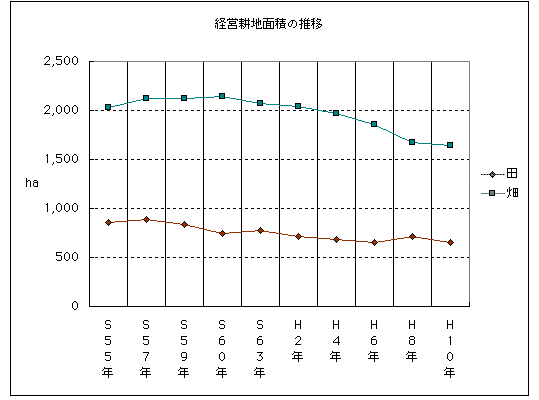
2) 【家畜廃棄物を管理する】家畜尿汚水など畜産廃棄物を河川や地下水へ流さない
家畜の糞尿や汚水を不適切に処理すると、付近の河川や地下水を汚染する可能性があります。そのような事態を防ぐため、水質汚濁防止法によって、pH※12、BOD、COD(注13)、SS(注14)、大腸菌群数、窒素、リンの排出基準を定めています。
ニセコ町では、家畜尿汚水などによる環境汚染を防ぐため、これまで畜産堆肥舎の整備を積極的に進めてきました。14年度には、ほぼ全ての畜産農家の整備が完了します。また、畜産農家から排出される畜糞や家庭から出る厨芥ごみ(生ゴミ)、下水道汚泥を合わせて堆肥化する「堆肥センター」を整備します。
注12: 「pH」=「水素イオン濃度指数」とも言い、酸性又はアルカリ性の程度を示す尺度です。中性の水ではPhは7、酸性の溶液は数値が7より小さく、アルカリ性の溶液は数値が7から14の間になります。
注13: 「COD」=「化学的酸素要求量」とも言い、水中の汚濁物質(主として有機物質)を化学的に酸化させるときに消費される酸素剤の量をそれに相当する酸素の量で表したものです。この値が大きいほど水は汚濁されていることになる点でBODに似てますが、河川など流水への汚濁負荷を求める場合にはBODを主な指標にし、湖沼・海域など滞留時間が長い水系にはCODを主な指標にします。
注14: 「SS」=「浮遊物質量」とも言います。水の濁りの原因となるような、水中に浮遊している小粒状の懸濁性物質です。魚類のえらをふさいで斃死させたり、日光の透過を妨げることによって、水生植物の光合成作用を妨害するなどの有害作用があります。
目標達成に向けた手だてと主体別の行動項目
ニセコ町では、家畜尿汚水などによる環境汚染を防ぐため、これまで畜産堆肥舎の整備を積極的に進めてきました。14年度には、ほぼ全ての畜産農家の整備が完了します。また、畜産農家から排出される畜糞や家庭から出る厨芥ごみ(生ゴミ)、下水道汚泥を合わせて堆肥化する「堆肥センター」を整備します。
注12: 「pH」=「水素イオン濃度指数」とも言い、酸性又はアルカリ性の程度を示す尺度です。中性の水ではPhは7、酸性の溶液は数値が7より小さく、アルカリ性の溶液は数値が7から14の間になります。
注13: 「COD」=「化学的酸素要求量」とも言い、水中の汚濁物質(主として有機物質)を化学的に酸化させるときに消費される酸素剤の量をそれに相当する酸素の量で表したものです。この値が大きいほど水は汚濁されていることになる点でBODに似てますが、河川など流水への汚濁負荷を求める場合にはBODを主な指標にし、湖沼・海域など滞留時間が長い水系にはCODを主な指標にします。
注14: 「SS」=「浮遊物質量」とも言います。水の濁りの原因となるような、水中に浮遊している小粒状の懸濁性物質です。魚類のえらをふさいで斃死させたり、日光の透過を妨げることによって、水生植物の光合成作用を妨害するなどの有害作用があります。
- 目標達成の手だてと重点的な手だて
- 家畜の糞尿など汚水が河川や地下水に流入しないようにします。
- 家畜の糞尿を堆肥化するシステムを整備します。→【重点的な手だて】
- 堆肥舎の適正管理をすすめます。
- 目標値:畜産廃棄物の町内堆肥化率=100%
目標達成に向けた手だてと主体別の行動項目
| 目標達成の手だて | わたしたち町民の行動項目 | コミュニティの行動項目 | 事業者の行動項目 | 行政(役場)の行動項目 |
| 1.家畜の糞尿など汚水の河川や地下水への流入を防止する | ・家畜の糞尿などが河川や地下水に直接流入しないよう、適切に管理する | ・定期的な点検と助言 | ||
| 2.家畜の糞尿を堆肥化する【重点的な手だて】 | ・家畜の糞は堆肥センターに搬入して堆肥化する・家畜の尿の液肥化検討 | ・堆肥センターの早期の効率的稼働・堆肥品質の維持管理支援 | ||
| 3.堆肥舎の適正管理を進める | ・堆肥舎の適正管理 | ・定期的な点検と助言 |
- 目標値の背景となる指標D=畜産廃棄物の堆肥化率(グラフ)
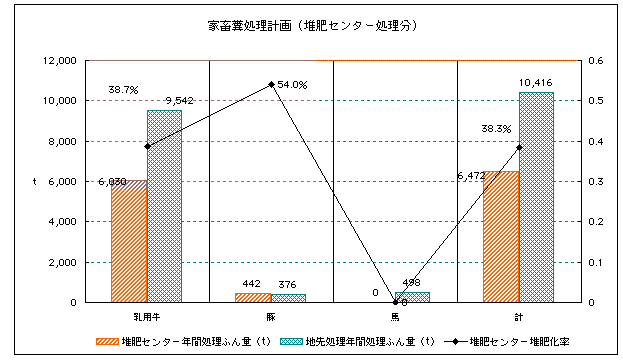
(3)生活空間における健全な水循環を確保する
1)【生活排水をそのまま流さない】合併処理浄化槽などの利用を促進し、観光・農村地域の生活排水による公共用水域の水質悪化を防ぐ
単独処理浄化槽は、し尿は処理しますが生活雑排水(台所や風呂の排水)は処理しません。河川の汚れの主な原因の一つは、この生活雑排水です。したがって、生活雑排水も合わせて処理する合併処理浄化槽の普及は、水循環への環境負荷を低減する上で大きな役割を果たします。
町では、合併処理浄化槽の整備を進めるために、平成12年度から「合併処理浄化槽設置整備事業補助金交付要綱」を設け助成を行っていますので、これを活用しながら合併処理浄化槽の普及をはかる必要があります。
目標達成に向けた手だてと主体別の行動項目
町では、合併処理浄化槽の整備を進めるために、平成12年度から「合併処理浄化槽設置整備事業補助金交付要綱」を設け助成を行っていますので、これを活用しながら合併処理浄化槽の普及をはかる必要があります。
- 目標達成の手だてと重点的な手だて
- 合併処理浄化槽の導入を促進します。→【重点的な手だて】
- 生活排水に関するライフスタイルを見直します。
- 目標値:合併浄化槽整備基数=100基(2004年度まで)
目標達成に向けた手だてと主体別の行動項目
| わたしたち町民の行動項目 | コミュニティの行動項目 | 事業者の行動項目 | 行政(役場)の行動項目 |
| ・合併処理浄化槽を導入する | ・地域単位で導入促進を図る | ・合併処理浄化槽を導入する | ・助成補助制度の効果的運営による合併処理浄化槽導入の支援・コミュニティプラントなど合併処理浄化槽以外の浄化手法の検討を進める |
| ・生活排水はなるべく汚さないよう配慮する(特に台所からの排水)・中水(上水の再利用)の利用 | ・中水(上水の再利用)の利用 | ・中水(上水の再利用)などの利用方法を提案する |
- 目標値の背景となる指標E=合併浄化槽敷設達成状況(グラフ)
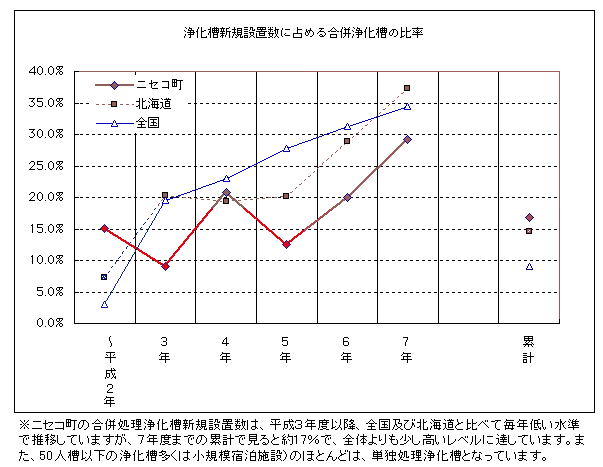
2)【公共下水道を利用する】生活排水の汚濁濃度を軽減することにより、下水道処理の負担を低減する
し尿、生活雑排水とも処理されている人口の比率を「生活排水処理率」といいます。この比率は、流域河川に汚濁負荷を及ぼさない度合を示しています。この生活排水処理率を、ニセコ町と北海道全体および全国平均で比較すると、平成5年度までの段階では、ニセコ町の生活排水処理施設(下水道や合併処理浄化槽)の整備の遅れが目立ちます。生活排水処理率を高めて、水循環への環境負荷を低く抑えることが課題です。
ニセコ町では、市街地中心部を対象に特定環境保全公共下水道を新規整備し、平成12年度に供用開始しています。これにより、ニセコ町における生活排水処理率を、平成12年度の22%から、計画目標年次の平成23年度には95%に向上させることができます。ここでは、生活排水処理のアイディアを私たちが出し合いながら、公共下水道利用による水洗化率を高めることにより、生活排水処理率全般の向上を目指します。
目標達成に向けた手だてと主体別の行動項目
ニセコ町では、市街地中心部を対象に特定環境保全公共下水道を新規整備し、平成12年度に供用開始しています。これにより、ニセコ町における生活排水処理率を、平成12年度の22%から、計画目標年次の平成23年度には95%に向上させることができます。ここでは、生活排水処理のアイディアを私たちが出し合いながら、公共下水道利用による水洗化率を高めることにより、生活排水処理率全般の向上を目指します。
- 目標達成の手だてと重点的な手だて
- 公共下水道による水洗化率を向上させます。
- 下水道処理の浄化負担を減らします。
- 生活排水の再利用や節水をすすめます。→【重点的な手だて】
- 道路などの清掃を行います。
- 目標値:水洗化率(人口比率)=85%
目標達成に向けた手だてと主体別の行動項目
| 目標達成の手だて | わたしたち町民の行動項目 | コミュニティの行動項目 | 事業者の行動項目 | 行政(役場)の行動項目 |
| 1.公共下水道による水洗化率を向上させる | ・公共下水道への接続 | ・公共下水道への接続 | ・公共下水道導入促進に向けたPR活動の徹底・処理水の水質維持管理 | |
| 2.下水道処理の浄化負担を軽減する | ・生活排水はなるべく汚さないよう配慮する | ・事業排水の流出前の汚れの軽減努力 | ・下水処理水の再利用の促進 | |
| 3.生活排水の再利用や節水を進める【重点的な手だて】 | ・風呂など一度使用した上水を雑用水(水洗トイレ用、散水など)として再利用する工夫 | ・ホテルなどにおける用水の再利用率の向上(ボイラー用水、製品処理、洗浄用水、冷却用水、温調用水など) | ・生活排水の再利用の方法を提案する | |
| ・雨水浸透ますの利用 | ・雨水浸透施設の導入 | ・雨水の浸透施設など、再利用を進めるシステムの検討 | ||
| 4.道路などの清掃を行う | ・玄関前など身近な道路や家のまわりの清掃 | ・地域内の清掃活動 | ・事業所周辺や近くの道路の清掃 | ・道路の清掃により、降雨時の河川への負荷の軽減を図る |
- 目標値の背景となる指標I=生活排水の処理形態別人口
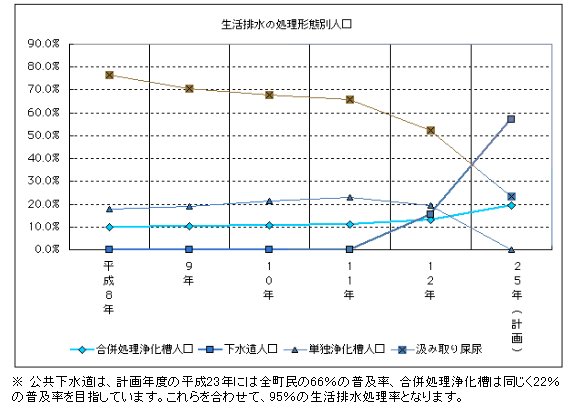
3)【水に親しむ仕組みをつくる】水辺と触れあう親水性のライフスタイルをつくる
平成12年のアンケート調査によると、水辺環境に関する町民の満足度評価は100点満点で64.4にとどまっており、比較的厳しい評価といえます。この背景には、水辺の眺めや近づきやすさ、水質や水量などがあまり良好ではない、と感じている町民意識があるようです。この背景には、水辺で遊んだり散歩するなどのライフスタイルが少なくなった上に、コンクリートによる護岸工事などで近づきにくい川が増え、殺風景な河川風景になったこと、生活排水や農業廃水などの流入が増えて水が汚れたこと、森が減って水量が少なくなったことなどの事情がありそうです。
このような状況を変えるためには、なによりも地域に住む私たちがもっと水辺に親しみ、河川のようすやその変化に敏感になることが出発点です。普段から親しんだ水辺を、もっとよくしたい、という具体的な活動は、そのような親水活動の中から生まれてきます。
目標達成に向けた手だてと主体別の行動項目
このような状況を変えるためには、なによりも地域に住む私たちがもっと水辺に親しみ、河川のようすやその変化に敏感になることが出発点です。普段から親しんだ水辺を、もっとよくしたい、という具体的な活動は、そのような親水活動の中から生まれてきます。
- 目標達成の手だてと重点的な手だて
- さまざまな親水活動のプログラム開発を行います。
- 町民の親水活動を促進します。→【重点的な手だて】
- 灌漑溝や用排水賂の環境共生化と親水化を検討します。
- 親水活動による水環境の観察結果を環境改善に活用するため、河川利用のルールをつくります。
- 親水活動に関する各種NPOや住民団体の活動を促進します。
- 総合的学習に親水活動を導入する環境教育プログラムを作成実施します。
- 目標値:親水活動の参加者数=延べ1,000人、
目標達成に向けた手だてと主体別の行動項目
| 目標達成の手だて | わたしたち町民の行動項目 | コミュニティの行動項目 | 事業者の行動項目 | 行政(役場)の行動項目 |
| 1.さまざまな親水活動のプログラム開発を行う | ・親水活動プログラム開発への町民参加・参加したくなるような魅力的な仕組みづくり | ・ボランティアレンジャーなどの説明指導員を育成 | ・ラフティングなど事業者による親水活動のプログラム開発と利用ルールの啓発・親水活動の事業化と適切な運営・モーターバイクなど河川に負荷のかかる活動や事業の自粛 | ・親水活動プログラムの普及促進・尻別川流域情報センターニセコ窓口の設置・かつての馬鈴薯澱粉工場の水車の復元などによる体験型親水拠点の指定、整備・ニセコ大橋下の河川親水活動拠点の整備検討 |
| 2.町民の親水活動を促進する【重点的な手だて】 | ・親水活動への参加・親水活動のルールづくり・ボランティアレンジャーなどの説明指導員のシステム作りと人材探しおよび人材育成・親水活動マイスター制度への登録や、マイスターを活用するような親水活動の展開 | ・ボランティアレンジャーなどの説明指導員を育成・親水活動マイスターの制度の活用 | ・町民と協働で、親水活動の場づくりを行う・親水活動マイスターに対するさまざまな支援 | ・親水活動などの仕組みづくりをおこなう・親水活動の場の設定と整備・子どもが遊べる親水ポイント「川のプール」の設置・親水活動マイスターの制度の創設(認証システムの提案) |
| 3.灌漑溝や用排水路の環境共生化と親水化を検討する | ・工法デザインへの町民参加 | ・親水化に伴うグランドデザイン作成への地域参加 | ・灌漑溝や用排水路を生物が生息できるデザイン工法を検討する | ・工法の切り替え条件の整備・歴史的資源である有島灌漑溝を活用した親水ポイントの整備(エコミュージアムのネットワーク) |
| 4.親水活動による水環境の観察結果を環境改善に活用するため、河川利用のルールをつくる | ・親水活動によって得た観察結果を、水環境改善の町民活動に結びつける・川の絵地図づくり・町民の手による川のデータベースづくり・ボランティア河川清掃活動 | ・ボランティアレンジャーなどの説明指導員を育成・釣りやアウトドアレジャーなどの河川利用のルールづくり | ・親水活動の事業の中で得られた水環境の観察結果を、行政に提供する | ・町民や事業者などから提供された水環境の状況情報を、環境整備に活用する仕組みづくり・フィッシングエリア(釣り体験ゾーン)の設定・釣りやアウトドアレジャーなどの河川利用のルールづくりの支援・他自治体や民間団体との連携 |
| 5.親水活動に関する各種NPOや住民団体の活動を促進する | ・親水活動や水環境に関わるNPOや住民団体の活動への参加 | ・さまざまな活動支援 | ・NPOや住民団体の活動への支援 | ・NPOや住民団体の活動への支援や認定 |
| 6.総合的学習に親水活動を導入する環境教育プログラムを作成実施する | ・総合的学習への町民参加、親の参加 | ・ボランティアレンジャーなどの説明指導員を育成 | ・総合的学習の場の提供 | ・総合的学習プログラム作成支援・野外スクールシステムの仕組みづくり |
- 目標値の背景となる指標G=アンケート調査に見る町民の親水意識
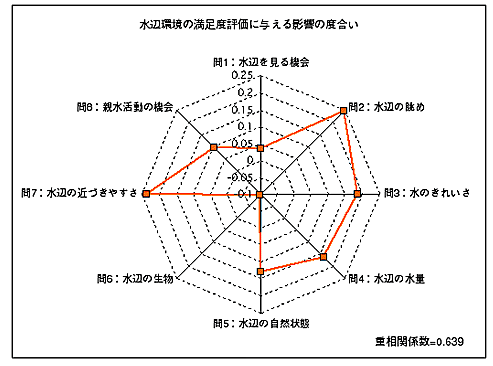
(4)河川、湖沼、地下水などにおける、自然生態系に依拠した水循環を取り戻す
1)【川の水を守る】河川の水際線の自然地を保全し、生物生態系の維持と、河川水質浄化機能を向上する
ニセコ町より上流の尻別川の地点流量と下流域の流量を比べてみると、どの地点のデータもほぼ30年間で流量が減少傾向にあることを示しています。なかでも下流域(蘭越町名駒地点)の減少傾向の方が上流域(喜茂別地点)の減少傾向よりも大きいのは、その間の変化要因に大きく左右されているからと思われます。ニセコ町域での流量の変化は倶知安地点と昆布地点の差に表れますが、平成1~3年度の範囲では、ニセコ町内で流量がさほど増減していないことがわかります。
水質(注16)に関する測定結果を見ると、ニセコ町内の2つの測定地点の間には市街地が広がっているので、芙蓉橋と真狩橋の2つのデータの差が市街地からの水質汚濁負荷、という大雑把な捉え方が可能です。pH、DOはいずれも大きな変化がなく、汚濁負荷はほとんど発生していないように見えます。しかし、BODは真狩橋でわずかに高い値となっており、真狩川上流部からの影響が見られます。またSSは、上流域喜茂別町内相川橋とニセコ町内芙蓉橋で値が高くなっているほか、全体として河口に近づくにつれ、値が大きくなっています。泥土や生活排水、産業排水などの流出は河床の荒廃を引き起こし、河川の生態系を著しく変化させます。なかでも、サケ、マスなどの降下魚類にも悪影響が及ぶことが想定されます。
川の水を守ることは、流域に生息する生物や生成物の環境を守ることにつながります。そのためには、普段から河川などの流域に生息する様々な野生生物を観察し、その変化などに関心を向ける必要があります。水質の変化は、計測器のデータ以上に、野生生物の生息状況に一層敏感に反映するからです。
観察結果は水環境のデータベースとして整備され、流域に生きる私たち人間を含むすべての生物のいのちを保全するための施策に生かされます。尻別川水系は、ニセコ町の上流部から下流部まで関係町村が広域でネットワークを組み、広域にわたる保全条例などを含む、保全と利活用の仕組みづくりを進めることが必要です。
一方では、町内外からのゴミの不法投棄が後を絶ちません。不法投棄は人目を避けられる場所を選んで行われるので、河川流域などはその格好の対象になっています。河川周辺への不法投棄は、ゴミの流入による水質汚濁や汚染の原因になります。町では、警察と連携して不法投棄の防止に努めていますが、今後は、不法投棄を防ぐ一層の仕組みづくりや意識改革など、さまざまな努力が広域にわたって求められます。
トンネル工事に伴う排水は、抗口付近の河川に排出されますが、町内のルートではルベシベ川と真狩川の水質への影響が想定されています。また、トンネルが地下水の帯水層などに影響を与える可能性も指摘されており、ニセコ山地や羊蹄山麓の豊富な地下水(山麓全体で30万立方メートル/日の湧水量と想定)が枯渇する危険性を心配しなければなりません。そのほかにも、重金属系の土壌が含まれる鉱化変質帯をトンネルが貫く場合の土壌汚染の懸念など、様々な課題が指摘されています。これらの課題については、適切な技術対応や有識者などによる検討委員会の設置による解決が提案されていますが、私たち町民もこれらの課題について関係機関とともに考え、問題解決にあたる必要があります。
目標値:水質(BOD値)=町内全域で平均0.5以下
目標達成に向けた手だてと主体別の行動項目
- 注15: 「流量」というのは、河川のある地点での横断面を単位時間内に流過する水の体積を指します。河川の流量に影響を与える要因には、降水量、伐採など森林の変化によるかんよう涵養機能の変化、水源取水、支流からの流入、農業や工業による取排水、ダムなどによる流量規制など多様な原因が考えられます。
水質(注16)に関する測定結果を見ると、ニセコ町内の2つの測定地点の間には市街地が広がっているので、芙蓉橋と真狩橋の2つのデータの差が市街地からの水質汚濁負荷、という大雑把な捉え方が可能です。pH、DOはいずれも大きな変化がなく、汚濁負荷はほとんど発生していないように見えます。しかし、BODは真狩橋でわずかに高い値となっており、真狩川上流部からの影響が見られます。またSSは、上流域喜茂別町内相川橋とニセコ町内芙蓉橋で値が高くなっているほか、全体として河口に近づくにつれ、値が大きくなっています。泥土や生活排水、産業排水などの流出は河床の荒廃を引き起こし、河川の生態系を著しく変化させます。なかでも、サケ、マスなどの降下魚類にも悪影響が及ぶことが想定されます。
- 注16:「水質」を評価する指標には、pH(水素イオン濃度)、BOD(生物化学的的酸素要求量)、COD(化学的酸素要求量)、SS(浮遊物質量)、DO(溶存酸素量)などがあります。特に、河川など流水への汚濁負荷を求める場合にはBODを主な指標にし、湖沼・海域など滞留時間が長い水系にはCODを主な指標にします。
川の水を守ることは、流域に生息する生物や生成物の環境を守ることにつながります。そのためには、普段から河川などの流域に生息する様々な野生生物を観察し、その変化などに関心を向ける必要があります。水質の変化は、計測器のデータ以上に、野生生物の生息状況に一層敏感に反映するからです。
観察結果は水環境のデータベースとして整備され、流域に生きる私たち人間を含むすべての生物のいのちを保全するための施策に生かされます。尻別川水系は、ニセコ町の上流部から下流部まで関係町村が広域でネットワークを組み、広域にわたる保全条例などを含む、保全と利活用の仕組みづくりを進めることが必要です。
一方では、町内外からのゴミの不法投棄が後を絶ちません。不法投棄は人目を避けられる場所を選んで行われるので、河川流域などはその格好の対象になっています。河川周辺への不法投棄は、ゴミの流入による水質汚濁や汚染の原因になります。町では、警察と連携して不法投棄の防止に努めていますが、今後は、不法投棄を防ぐ一層の仕組みづくりや意識改革など、さまざまな努力が広域にわたって求められます。
- 北海道新幹線建設工事計画について
トンネル工事に伴う排水は、抗口付近の河川に排出されますが、町内のルートではルベシベ川と真狩川の水質への影響が想定されています。また、トンネルが地下水の帯水層などに影響を与える可能性も指摘されており、ニセコ山地や羊蹄山麓の豊富な地下水(山麓全体で30万立方メートル/日の湧水量と想定)が枯渇する危険性を心配しなければなりません。そのほかにも、重金属系の土壌が含まれる鉱化変質帯をトンネルが貫く場合の土壌汚染の懸念など、様々な課題が指摘されています。これらの課題については、適切な技術対応や有識者などによる検討委員会の設置による解決が提案されていますが、私たち町民もこれらの課題について関係機関とともに考え、問題解決にあたる必要があります。
- 目標達成の手だてと重点的な手だて
- 尻別川とその支流の水質維持向上をはかります。
- 河畔林、魚付き林の保全、回復を図ります。→【重点的な手だて】
- 水際への不法投棄を行わないような町内外への広域的な啓発活動を行います。
- 水質浄化機能を保全するため、河川流域の自然生態系を保全します。
- 流域の生態系に生息する野生生物の実態を把握し、保全策を講じます。
- 町内を通ると予想される北海道新幹線のトンネル工事による地下水や河川への影響を最小限にとどめるよう、関係機関に働きかけます。
- 尻別川水系の全般的な保全策を進めるために、流域の他町村と広域的な連携をはかります。
目標値:水質(BOD値)=町内全域で平均0.5以下
目標達成に向けた手だてと主体別の行動項目
| 目標達成の手だて | わたしたち町民の行動項目 | コミュニティの行動項目 | 事業者の行動項目 | 行政(役場)の行動項目 |
| 1.尻別川とその支流の水質維持向上を図る | ・水質日本一の尻別川を実感するフィールドウオッチングの実施・支流へ汚水を流出しない | ・地域による支援の仕組みづくり | ・支流への汚水の流出をしない | ・水質保全監視体制の仕組みづくり・水質悪化河川の実態把握と改善方策の実施・凍結道路融雪剤の河川への影響の有無について調査を行う |
| 2.河畔林、魚付林き林の保全・回復を図る【重点的な手だて】 | ・堤防、河畔の植林事業への参加 | ・地域による支援の仕組みづくり | ・堤防、河畔の植林 | ・堤防、河畔の自生樹木の伐採抑制と適正樹木の植樹 |
| 3.水際への不法投棄を行わないような町内外への広域的な啓発活動を行う | ・ゴミ不法投棄のチェックと清掃ボランティア活動 | ・ボランティア受け入れの仕組みづくり・釣りの規制エリアに関するルールづくり | ・不法投棄を行わない事業所内教育と廃棄物処理体制の構築 | ・広域的連携に向けた協議組織の立ち上げと啓発活動の実施・不法投棄指導体制の仕組みづくり・釣りの規制エリアの設定 |
| 4.水質浄化機能を保全するため、河川流域の自然生態系を保全する | ・自然河川で釣りやハイキング、川遊び、などの親水活動レクリエーション | ・地域による支援の仕組みづくり | ・自然河川の実態調査とPR | |
| 5.流域の生態系に生息する野生生物の実態を把握し、保全策を講ずる。 | ・水生生物など、流域の野生生物を観察し、記録を続ける。・流域の野生生物の保全活動に参加する。 | ・水系の野生生物などの観察や保全行動に協力する。 | ・水系の野生生物などの観察や保全行動に協力する。 | ・町民が調査した流域の野生生物の記録をデータベースに整備し、保全活動の参考に資する。・流域生態系の保全策について検討する。 |
- 注17:「ワイズユース」:自然環境に負荷を与えず、その価値を体験したり学んだりして、自然環境資源を多角的に賢く利用しようという試みを指します
- 目標値の背景となる指標H=観測地点における流量
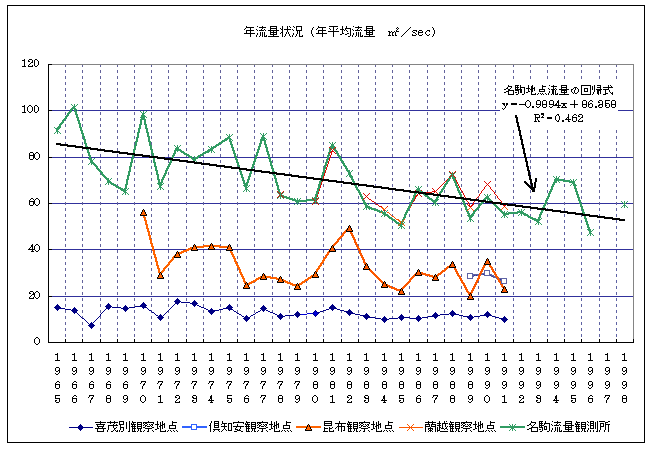
- 目標値の背景となる指標I=観測地点における水質
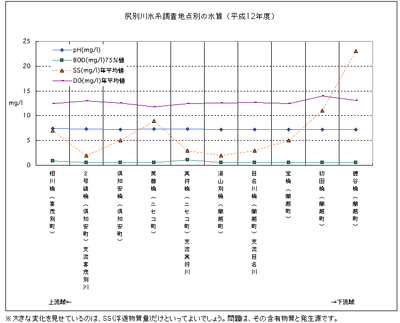
2)【川を自然に戻す】野生生物の接近を阻むコンクリートによる三面張りの護岸を見直し、自然に近い改修工法によって、河川流域の生態系を回復する
これまでは、洪水を迅速に流下させることを主な目的にして、川の直線化とコンクリート護岸、および砂防ダムや取水堰堤、落差工(注18)などの河川横断工作物による整備が進められてきました。ニセコ町域を流れる尻別川の支流は、急峻な地形を反映して上流部付近は25度以上の急傾斜となっているので、とくにこのような人工的河川整備が施されてきました。砂防指定地も4箇所あります。このため、河川周辺の自然が減り、生物の多様な生息・繁殖地を奪い、河川の水質の浄化機能をも妨げる結果を招いています。
また、落差の大きな河川横断工作物は、サケなどの降下魚類の遡上にも影響を与え、海洋から陸地への栄養物質の還元という物質循環を阻害する結果を招いています。
近年、多自然型工法(注19)による河川整備が進められてきました。私たち町民が主体となりどのような工法が最良なのか検討し、一層自然に近い工法を導入しながら、自然河川に近い環境を復元していくことが求められます。
また、落差の大きな河川横断工作物は、サケなどの降下魚類の遡上にも影響を与え、海洋から陸地への栄養物質の還元という物質循環を阻害する結果を招いています。
近年、多自然型工法(注19)による河川整備が進められてきました。私たち町民が主体となりどのような工法が最良なのか検討し、一層自然に近い工法を導入しながら、自然河川に近い環境を復元していくことが求められます。
- 注18: 「落差工」:砂防ダムなど、河川を横断して落差を設け、土砂や水の移動を調整するための施設を指します。
- 注19: 「多自然型工法」:河川での生物の生息や生育に配慮して瀬や淵などの水際をつくり、コンクリートに土をかぶせることで植生の維持を図ったり、落差の緩やかな魚道を設けたり、自然材を組み合わせるなど、自然に近い状態を目指す護岸工法を言います。近年の護岸工事は、多自然型が多くなりつつありますが、工法の研究開発と情報収集が必要です。
- 目標達成の手だてと重点的な手だて
- 流域全体を対象とした生態系と護岸工法の実態調査を行い、地域特性に応じた改修のあり方に関する計画を策定します。→【重点的な手だて】
- 落差の大きな砂防ダムを、小さな落差工に改修します。
- 魚道を確保し、すべての河川で回遊魚の遡上を確保します。
- 河床のコンクリート張りを撤去するなど、コンクリート3面張りによる護岸を取り除いて、自然河川に近い状態に修復します。
- 目標値:自然に近い護岸改修箇所数=3箇所以上
- 目標達成に向けた手だてと主体別の行動項目
| 目標達成の手だて | わたしたち町民の行動項目 | コミュニティの行動項目 | 事業者の行動項目 | 行政(役場)の行動項目 |
| 1.複相林の植林を促進する | ・小規模伐採の跡地への複層林の植林を進める | ・植林活動への協力 | ・小規模伐採の跡地への複層林の植林を進める | ・小規模伐採の跡地への複層林の植林を進める・「森林整備計画」に基づく育林 |
| 2.育林産業を振興する | ・育林ボランティアあるいはNPOの活動を町内外に展開する | ・ボランティア受け入れの仕組みづくり・ボランティア活動の団体づくり | ・新規就業者の発掘 | ・新規就業促進の仕組みづくり |
| 3.間伐材や林産物のリサイクルを進める【重点的な手だて】 | ・消費者からの商品ニーズの発信 | ・間伐材を活用したリサイクル製品の開発(木炭製造など)と市場開拓 | ・間伐材利用方法の検討・新規事業化の支援 | |
| ・間伐材やおが屑、樹皮などの林産物は堆肥センターなどで堆肥化する | ・堆肥センターの早期の効率的稼働 |
- 目標値:植林及び林相改良の面積
(「ニセコ町森林整備計画より」目標年次:2032年)
3)【美しい景観を守る】河川流域の水と緑が織りなす、ニセコらしい空間と景観を保全する土地利用を進める
河川流域の地形や河畔林・渓畔林の自然植生は、地域特性を反映した景観の基礎条件です。尻別川のニセコ町内の流域は、その多くが河岸段丘※20となっているため、概して近づきにくい地形を保っており、多くの樹木(ヤナギ低木群落主体の河畔林とエゾイタヤーシナノキ群落などの傾斜緑地)に覆われた植生と相まって、自然度の高い景観を織りなしています。また、真狩川や昆布川等に代表されるたくさんの支流は、その多くが農村地帯を流れます。これら支流は、田畑と調和した自然河川の趣をとどめている一方、コンクリート護岸によって生態系も一変した人工的な河川まで、多様な景観を織りなしています。
景観はまた、周辺の土地利用によって大きく左右されます。ニセコ町の河川周辺の土地は、一部市街地周辺を流域としている他は、農地と森林地域としての土地利用が多く、市街地、農地それぞれの要因によってニセコらしい水と緑の河川景観が損なわれないよう、さまざまな配慮が必要です。
目標達成に向けた手だてと主体別の行動項目
景観はまた、周辺の土地利用によって大きく左右されます。ニセコ町の河川周辺の土地は、一部市街地周辺を流域としている他は、農地と森林地域としての土地利用が多く、市街地、農地それぞれの要因によってニセコらしい水と緑の河川景観が損なわれないよう、さまざまな配慮が必要です。
- 注20:「河岸段丘」=川の流路に沿って階段状になっている地形をいいます。
- 目標達成の手だてと重点的な手だて
- 総合的な土地利用計画を策定します。→【重点的な手だて】
- 景観条例を定め、河川流域の景観について基本的な方針を打ち出します。
- 景観構成要素ごとの保全と創造に関するガイドラインを作成します。
- 保全したい景観を発見するためのイベントを開催します。
- 目標値:保全したい景観の発見箇所数=100箇所程度
目標達成に向けた手だてと主体別の行動項目
| 目標達成の手だて | わたしたち町民の行動項目 | コミュニティの行動項目 | 事業者の行動項目 | 行政(役場)の行動項目 |
| 1.総合的な土地利用計画を策定する【重点的な手だて】 | ・民有地の土地利用に関する合意形成を進めるため、土地利用計画の策定に積極的に参加する | ・土地利用計画策定への地域参加 | ・民有地の土地利用に関する合意形成を進めるため、土地利用計画の策定に積極的に参加する | ・町民参加の土地利用計画づくりを進める ・土地利用の適性を図るための生態学的手法を導入する ・湿地や斜面など、未利用地であった土地の価値に関する調査を行う |
| 2.景観条例を定め、河川流域の景観について基本的な方針を打ち出す | ・条例づくりへの参加 | ・景観条例づくりへの地域参加 | ・条例づくりへの参加 | ・条例制定に向けた検討の場づくり |
| 3.景観構成要素ごとの保全と創造に関するガイドラインを作成する | ・景観評価に関する町民の感性をガイドラインの規定に反映させる | ・ガイドラインづくりへの地域参加 | ・景観を形成する工作物について、その建造主体としての責任ある対応を検討する | ・景観評価のシステムの開発 |
| 4.保全したい景観を発見するためのイベントを開催する | ・心に中で大切にしている景観を出し合う ・主体的な活動による景観マップづくり、写真撮影会、写生会、など、情報収集と表現の町民活動の展開 | ・地域単位で遺したい景観を捜し、保全や活用の方法を地域で考える | ・町民活動への支援 | ・町民活動への支援 ・イベントの開催 ・町民が保全したいと思っている景観の類型化や分析を行う |
このページの情報に関するお問い合わせ先
- 企画環境課環境モデル都市推進係
- TEL:0136-56-8837
- FAX:0136-44-3500